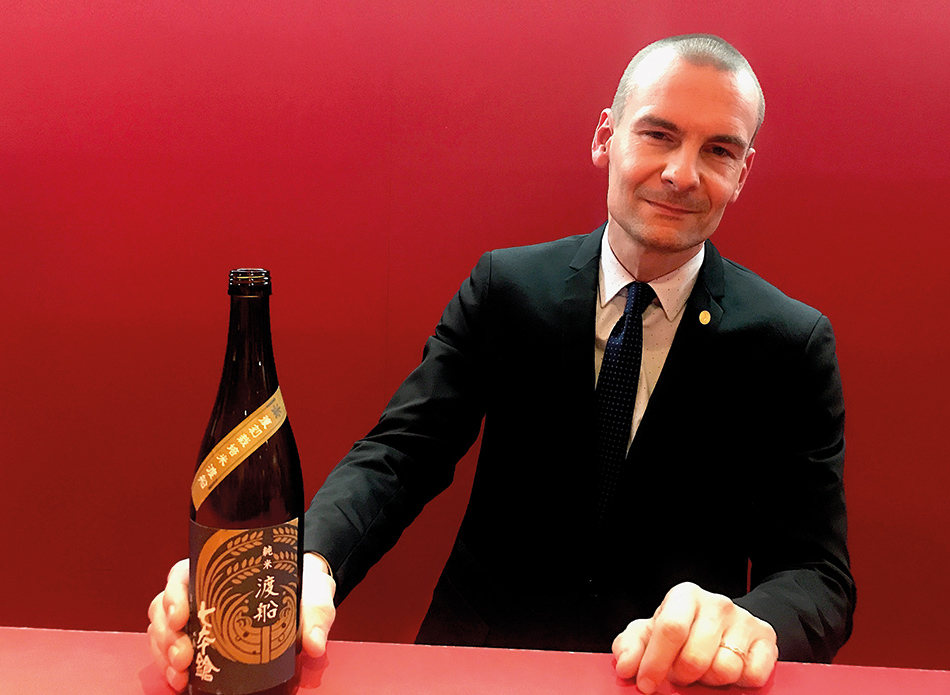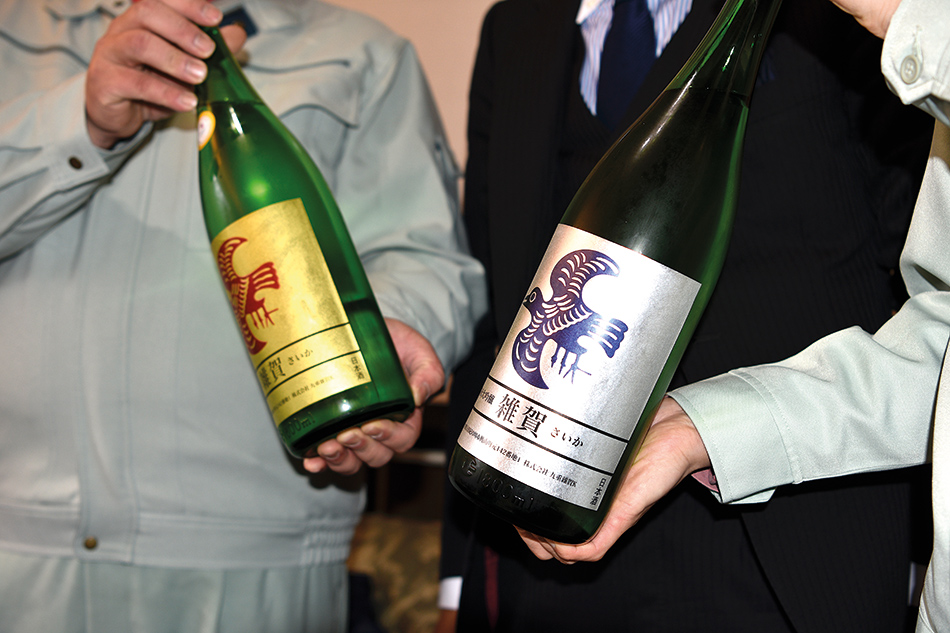
Sakes become essential on the European market. The sommeliers recognize the interest of its taste. The Kura Master competition was created in 2017 at the initiative of Kei Miyagawa and Xavier Thuizat, both sommeliers. It is the first to assess Japanese sakes by French prescribers–sommeliers, chefs, restaurateurs and other professionals of flavors. The next session will be held on May 27, 2019 with the will to give another visibility to these sakes in France. In view of this new edition, a trip was organized in Japan in January 2019 to raise awareness with some chef sommelier to these sometimes unknown beverages. Five of them had this experience, Xavier Thuizat (The Crillon Hotel, Paris), Eric Gottelmann (Bernard Loiseau), Baptiste Gauthier (Anne Sophie Pic, Valencia), Bernard Neveu (The Bristol, Paris) and Kevin Lemonnier (Ducasse). New trends of rice varieties, used in monovarietal or in blend, other sources and importance of the water, at the origin of the process of sake making like the cereal. Several prefectures were visited to catch the characteristics of their sakes. Each of them has premium sakes. The sommeliers spoke about some of them.
In Iwade, at the Kura Kokonoesaika, a masterclass organized about omachi rice sakes convinced everyone about the interest of this variety. Two 100% omachi sakes, of the same soil but different polishing rates, were tested. Their differences have confirmed the importance of polishing on the aromas. Xavier Thuizat has explained that the omachi 50, or 50% of remaining grain, facilitates the expression of the grape variety. The powerfulness, the nuances of fine spices (white pepper, caraway, precious wood) reveal a very great sake. The omachi 40, or 60% of remaining grain, see the grape characteristics a little reduced in powerfulness. His profile becomes purer and crystalline but less singular.
At a tasting in Hyogo, the Fukuju Junmai Daiginjo Nero (Kobe Shu Shin Kura Kan) has distinguished itself. The nose oscillates between the white fruits, the delicate green apple. On the palate, the very elegant acidity combines with notes of nashi pear, white flowers and verbena. The extremely delicate texture reminds flesh of white fruits. The salivating side completes the length. This sake transcribes an experiment used for 14 years, the use of a plastic box insulating the koji. The moto and the shubo benefit from a new configuration giving a very pure taste.

In Hiroshima, Xavier Thuizat chose to comment on the Ginjo Miyajima from Kura Miyake. He mentions his typicality with a powerful, spicy, traditional style. He suggests to heat it to 37°C and to accompany it with a hot foie gras with fermented avocado and a reduction of horseradish sauce. The spices of the horseradish will comfort those of the sake.
Eric Gottelmann has selected Shichi Hon Yari (Kura Tomita Shuzo). He evokes its colour, very delicate gold with a superb brilliance. He describes the scents, between citrus fruits and flowers, very delicate notes of pear. He mentions accents of lilac, shades of almonds. On the palate, it offers a sharp first taste, with a controlled acidity. In the finish, he notices tangy and spicy flavors. He says this sake has a nice balance. He would serve it at 10°C. He stresses on the fact that to optimize a sake, the choice of the temperature prevails. With too low degrees, the subtleties will not be noticeable. Above 10°C, the very expressive notes of spices may become too powerful. On the pairing side, he would consider a delicate dish, a scallop carpaccio with a dash of oil and just a hint of salt and pepper. He suggests to remain pure so as not to saturate the palate and give free rein to the richness of the sake. The light iodized side of the shellfish would transcend the expression of this sake and preserve its elegance. According to him, the ‘pairing’ potential of sake is greater than that of wines. Sakes match with every dish. Some taste associations, more refined, are exceptional, others more basic. He reminds us that sake is a flavor enhancer. For a sommelier, the interest is to create new possibilities for the customers.
Baptiste Gauthier chose Chiebijin Junmaishu, Nakano Shuzo, Prefecture of Oita (Kura Master Award of the Presidents 2018). He describes a subtle nose, floral, with scents of lychee, hawthorn, jasmine. Discovering the palate, he thought it was spellbinding, delicate, evolving towards a fine, balanced acidity. The long, pleasant finish is enhanced by light notes of pepper. A very digestive bitterness appears, giving a length equivalent to 6 caudalies. In pairing, he recommends a scallop carpaccio with citrus peel and a light passionfruit coulis. He suggests to control the temperature starting with 10°C at the beginning of the service to bring it up to 12°C gradually during the tasting.
Shin Kibayashi, co-author with his sister Yuko, of the famous manga “The Drops of God” is a prescriber in his own right. He gave his perception of sake Shichi Hon Yari. He appreciates the acidity giving it a certain palatibility and a very nice balance. He draws a parallel with the world of wine. The notes in the mouth by its slightly evolved side make him think of a Yquem. For the pairing, he thinks of a pork sauté in cream sauce, accompanied by candied lemons.
Being sommelier requires adaptability, an appetite to discover new beverages, namely to offer them a place on the table. Considering the enthusiasm of everyone during this trip, sake seduces sommeliers and various prescribers. No doubt, the French market is not yet mature, the new experiments (rice, water, concept of terroir) arouses the curiosity of the customers. Tasted pure in a premium version or in a cocktail, these precious liquids have become inevitable.

Baptiste Gauthier chose Chiebijin Junmaishu, Nakano Shuzo, Prefecture of Oita (Kura Master Award of the Presidents 2018). He describes a subtle nose, floral, with scents of lychee, hawthorn, jasmine. Discovering the palate, he thought it was spellbinding, delicate, evolving towards a fine, balanced acidity. The long, pleasant finish is enhanced by light notes of pepper. A very digestive bitterness appears, giving a length equivalent to 6 caudalies. In pairing, he recommends a scallop carpaccio with citrus peel and a light passionfruit coulis. He suggests to control the temperature starting with 10°C at the beginning of the service to bring it up to 12°C gradually during the tasting.
Shin Kibayashi, co-author with his sister Yuko, of the famous manga “The Drops of God” is a prescriber in his own right. He gave his perception of sake Shichi Hon Yari. He appreciates the acidity giving it a certain palatibility and a very nice balance. He draws a parallel with the world of wine. The notes in the mouth by its slightly evolved side make him think of a Yquem. For the pairing, he thinks of a pork sauté in cream sauce, accompanied by candied lemons.
Being sommelier requires adaptability, an appetite to discover new beverages, namely to offer them a place on the table. Considering the enthusiasm of everyone during this trip, sake seduces sommeliers and various prescribers. No doubt, the French market is not yet mature, the new experiments (rice, water, concept of terroir) arouses the curiosity of the customers. Tasted pure in a premium version or in a cocktail, these precious liquids have become inevitable.
Sofia Lafaye

In Hiroshima, Governor Hidehiko Yuzaki gave his concept of export to Europe. He insists on the need for Premium quality with traditional sakes but also others with a stylistically innovative profile. He also mentioned the need to stick a back label in the language of the importing country, or even in English. Interest in sake should go hand in hand with increased education.
Interview translated from japanese by Amandine Jousset